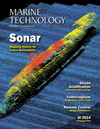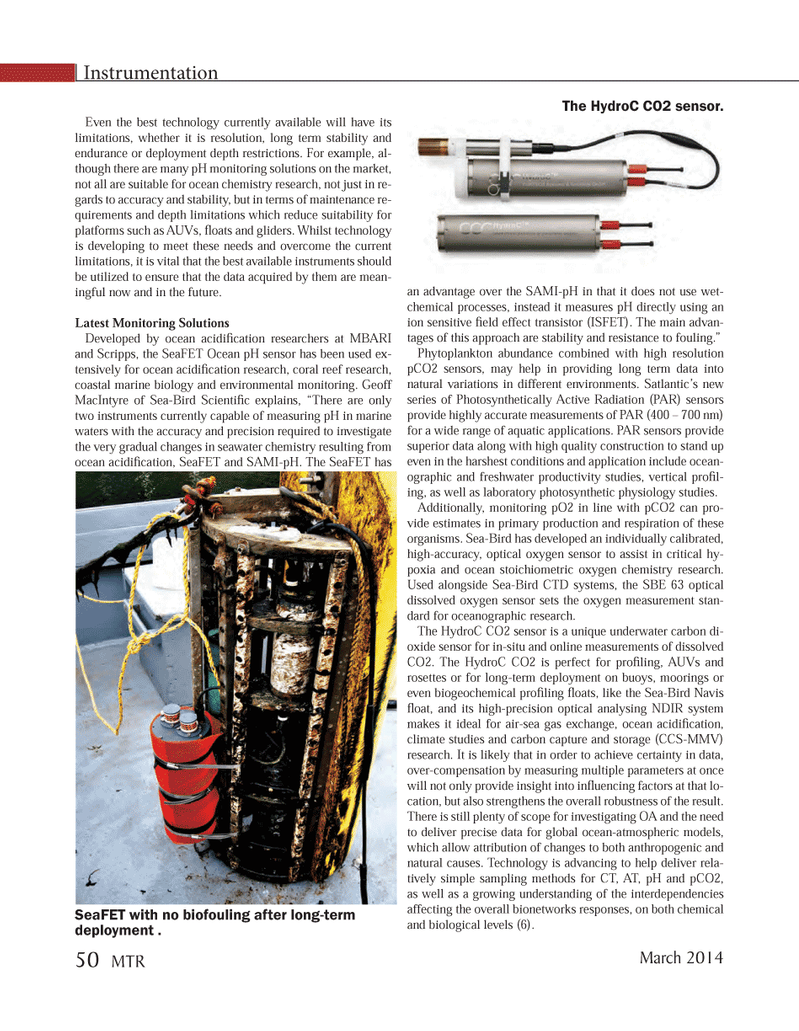
Page 50: of Marine Technology Magazine (March 2014)
Instrumentation: Measurement, Process & Analysis
Read this page in Pdf, Flash or Html5 edition of March 2014 Marine Technology Magazine
Even the best technology currently available will have its limitations, whether it is resolution, long term stability and endurance or deployment depth restrictions. For example, al- though there are many pH monitoring solutions on the market, not all are suitable for ocean chemistry research, not just in re-gards to accuracy and stability, but in terms of maintenance re- quirements and depth limitations which reduce suitability for platforms such as AUVs, ß oats and gliders. Whilst technology is developing to meet these needs and overcome the current limitations, it is vital that the best available instruments should be utilized to ensure that the data acquired by them are mean-ingful now and in the future. Latest Monitoring SolutionsDeveloped by ocean acidiÞ cation researchers at MBARI and Scripps, the SeaFET Ocean pH sensor has been used ex- tensively for ocean acidiÞ cation research, coral reef research, coastal marine biology and environmental monitoring. Geoff MacIntyre of Sea-Bird ScientiÞ c explains, ÒThere are only two instruments currently capable of measuring pH in marine waters with the accuracy and precision required to investigate the very gradual changes in seawater chemistry resulting from ocean acidiÞ cation, SeaFET and SAMI-pH. The SeaFET has an advantage over the SAMI-pH in that it does not use wet- chemical processes, instead it measures pH directly using an ion sensitive Þ eld effect transistor (ISFET). The main advan- tages of this approach are stability and resistance to fouling.Ó Phytoplankton abundance combined with high resolution pCO2 sensors, may help in providing long term data into natural variations in different environments. SatlanticÕs new series of Photosynthetically Active Radiation (PAR) sensors provide highly accurate measurements of PAR (400 Ð 700 nm) for a wide range of aquatic applications. PAR sensors provide superior data along with high quality construction to stand up even in the harshest conditions and application include ocean- ographic and freshwater productivity studies, vertical proÞ l-ing, as well as laboratory photosynthetic physiology studies. Additionally, monitoring pO2 in line with pCO2 can pro- vide estimates in primary production and respiration of these organisms. Sea-Bird has developed an individually calibrated, high-accuracy, optical oxygen sensor to assist in critical hy- poxia and ocean stoichiometric oxygen chemistry research. Used alongside Sea-Bird CTD systems, the SBE 63 optical dissolved oxygen sensor sets the oxygen measurement stan- dard for oceanographic research. The HydroC CO2 sensor is a unique underwater carbon di- oxide sensor for in-situ and online measurements of dissolved CO2. The HydroC CO2 is perfect for proÞ ling, AUVs and rosettes or for long-term deployment on buoys, moorings or even biogeochemical proÞ ling ß oats, like the Sea-Bird Navis ß oat, and its high-precision optical analysing NDIR system makes it ideal for air-sea gas exchange, ocean acidiÞ cation, climate studies and carbon capture and storage (CCS-MMV) research. It is likely that in order to achieve certainty in data, over-compensation by measuring multiple parameters at once will not only provide insight into inß uencing factors at that lo- cation, but also strengthens the overall robustness of the result. There is still plenty of scope for investigating OA and the need to deliver precise data for global ocean-atmospheric models, which allow attribution of changes to both anthropogenic and natural causes. Technology is advancing to help deliver rela- tively simple sampling methods for CT, AT, pH and pCO2, as well as a growing understanding of the interdependencies affecting the overall bionetworks responses, on both chemical and biological levels (6). Instrumentation SeaFET with no biofouling after long-term deployment . The HydroC CO2 sensor. March 2014 50 MTRMTR #2 (50-65).indd 50MTR #2 (50-65).indd 502/21/2014 11:25:35 AM2/21/2014 11:25:35 AM

 49
49

 51
51
